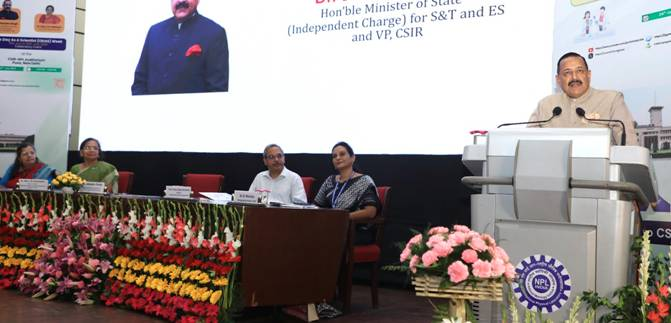Jigyasa’s ODAS Week Inspires Scientific Spirit, Minister Proposes Bold Expansions
Dr. Singh narrated touching moments from the interactions, including that of an eighth-grade girl from Dholpur, who expressed concern that her younger sister was unable to join the programme.

- Country:
- India
In a vibrant celebration of India’s youth-driven scientific spirit, Union Minister Dr. Jitendra Singh called for a transformative expansion of the CSIR Jigyasa Programme during the “One Day as a Scientist” (ODAS) week held at the CSIR-National Physical Laboratory (NPL). Addressing an audience of budding innovators, scientists, teachers, and parents, the Minister outlined a comprehensive vision for nurturing the aspirational surge among students with what he termed the “3 As” of youth development—Awareness, Aptitude, and Avenue.
Fulfilling Youth Aspirations Through Science
Speaking on the occasion, Dr. Singh emphasized that India's youth, bursting with questions and curiosity, must be given both knowledge (awareness) and training (aptitude), along with platforms (avenue) to convert their enthusiasm into tangible innovations. He particularly underscored the role of Jigyasa in aligning school-level exposure to science with long-term national goals of innovation and self-reliance.
“Children are not just asking questions—they’re solving problems,” said the Minister. “We must meet their energy with opportunity.”
Reinventing ODAS: Four New Proposals
Dr. Singh proposed four pioneering enhancements to the ODAS initiative, making it more inclusive, impactful, and sustained:
-
Parent Participation: He urged CSIR labs to invite at least one parent per student to experience ODAS firsthand, thus ensuring family-level understanding and encouragement of scientific exploration. This, he said, would protect students from disillusionment caused by lack of support at home.
-
‘One Day as a Teacher’ Programme: Reversing the ODAS format, he proposed that CSIR scientists visit the students’ schools, particularly in rural and semi-urban areas, to inspire not just individuals but entire communities.
-
Private Sector Mentorship: Calling on industry partners—like those engaged in the EPIC Hackathon—Dr. Singh recommended that they adopt standout student projects for mentoring and support, effectively linking school innovation with real-world applications.
-
Student Tracking and Outcome Mapping: The Minister emphasized the need for long-term student tracking to help align future programme offerings with emerging interests and needs, thereby building a national scientific ecosystem from the ground up.
ODAS 2024: A Celebration of Curiosity and Creativity
This year’s ODAS week, inspired by Prime Minister Narendra Modi’s call to bring school students into real labs, saw participation from over 14,000 students across 37 CSIR laboratories. Students conducted guided experiments, shadowed scientists, and engaged with ongoing research—many for the first time in their lives.
Dr. Singh narrated touching moments from the interactions, including that of an eighth-grade girl from Dholpur, who expressed concern that her younger sister was unable to join the programme. “That’s the fire of aspiration,” he said, “and we must keep it alive.”
EPIC Hackathon 2024: Young Minds, Big Ideas
A major highlight of the event was the felicitation of EPIC Hackathon 2024 winners, a national innovation contest under the Jigyasa banner. The awarded projects showcased remarkable creativity, scientific depth, and social relevance:
-
1st Place: Japteg Bamrah (Pathankot, Punjab) SolarMech – A Stirling engine-based device powered by concentrated solar energy. It generates heat and power without requiring coolant, making it ideal for energy-scarce rural areas.
-
2nd Place: Uddhav Gupta & Udbhav Bandhani (Ghaziabad, UP) Drishyamitram – A smart walkway system for the visually impaired. It combines Arduino technology, RFID, and a mobile app for safe navigation and urban mobility.
-
3rd Place (tie): Shreya Vinod (Roorkee, Uttarakhand) A waste-heat-to-electricity converter using thermoelectric materials on air conditioners. Based on the Seebeck effect, it could make buildings more energy-efficient.
-
3rd Place (tie): Soyal Parija (Bhubaneswar, Odisha) I-Stetho – A wireless digital stethoscope that minimizes physical contact. It captures, amplifies, and transmits patient audio to devices, reflecting a powerful blend of IoT and healthcare.
“These young scientists are not just experimenting—they are problem solvers and innovators with clarity of thought,” said Dr. Singh. He stressed the importance of early mentorship and institutional support to convert such prototypes into entrepreneurial ventures.
Jigyasa: A Growing Scientific Movement
Launched in 2017, the Jigyasa programme has grown into one of India’s most significant science outreach platforms, with over 13.5 lakh students and 80,000 teachers engaged in more than 3,500 activities. It includes:
-
Lab visits and hands-on science modules
-
Virtual labs and innovation hackathons
-
Indian Sign Language-enabled (ISL) content
-
Mentorship programmes and live interactions
The platform is further bolstered by the National Education Policy (NEP) 2020, which encourages flexibility in subject choice, critical thinking, and interdisciplinary learning. “Earlier, choices were forced. Now students can evolve with their interests—and Jigyasa gives them the platform to do so,” said Dr. Singh.
Leaders and Scientists at the Helm
Dr. Jitendra Singh was joined by several eminent personalities and scientists on the occasion:
-
Dr. N. Kalaiselvi, Director-General, CSIR & Secretary, DSIR
-
Dr. Geetha Vani Rayasam, Head, CSIR-HRDG
-
Prof. Venu Gopal Achanta, Director, CSIR-NPL
-
Dr. D. Shailaja Donempudi, Head, Business Development Group at CSIR
Also present were representatives from industry, academia, and hundreds of students who embody the scientific future of India.
Looking Ahead: Towards India@2047
As India marches toward its centenary in 2047, Dr. Singh reiterated that the youth will be the principal drivers of innovation, growth, and global relevance. “Stay curious, stay bold, and never stop asking questions,” he told the students. “Because in every question lies the seed of discovery.”
With a renewed push for inclusivity, mentorship, and national-level engagement, the Jigyasa-ODAS initiative is poised to be a cornerstone of India’s next-generation scientific awakening.










